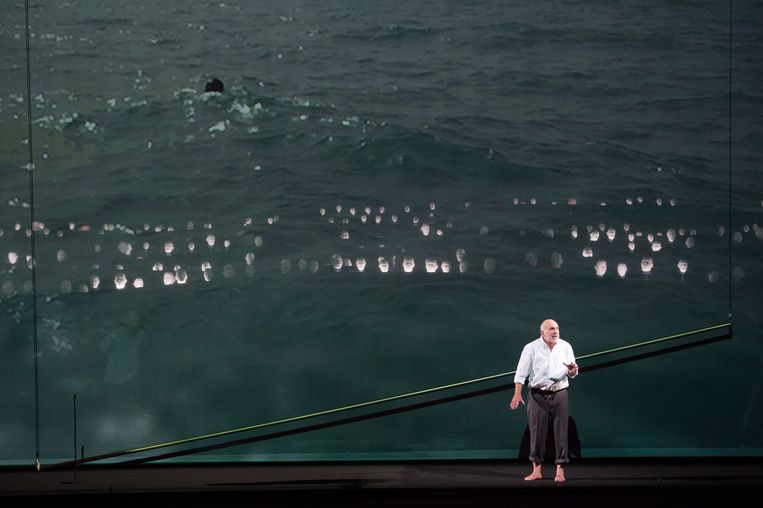A landmark production of Hans Werner Henze's Das Floß der Medusa (The Raft of the Medusa) conducted by Ingo Metzmacher in Amsterdam earlier this month, with Dale Duesing (Charon), Bo Skovhus and Lenneke Ruiten, with Cappella Amsterdam, the Nieuw Amsterdams Kinderen Jeugdkoor, and the Netherlands Philharmonic Orchestra, in a powerfully perceptive staging by Romeo Castellucci. Fifty years after its premiere, you'd expect that one of Henze's keynote works would be received with a bit more comprehension, but the complete lack of understanding exhibited by most of the press prove Henze was right. In 1968, protesters disrupted the first public performance. Henze could not stop the mobs, but was excoriated by the press. Some performers, who should have known better, since the piece wass dedicated to Che Guevara) turned on Henze to save their skins. Please read Henze's own words HERE)
Why such frenzy ? Surely everyone knows Théodore Géricault's famous painting of the raft, where Jean-Claude waves a red piece of cloth ? Moreover, Géricault was painting when the wreck of the Medusa was still raw political scandal. The rich had left the poor to die. What Géricault depicted was not lost on audiences at the time. The real horror is that modern audiences refuse to connect, even though we're surrounded by images or war, destruction and refugees drowing at sea. Even if the press don't know Henze, which is bad enough, surely some might have the humanity to think ? Traumatized after the debacle of the premiere, Henze wrote Versuch über Schweine a heartfelt scream of agony which is even more valid now than it was then.
Charon describes the stage directions, but we don't need to see them literally. Hearing disembodied voices call from the darkness is much more effective than clumsy movement on stage. In any case, we can hear the change of balance as the "dead" grow louder and more dominant, and the "living" fade. If we pay attention to the music, we can also hear the shift between winds (operated by human breath) to strings, something played with more wood than string. Henze's gift for writing for mixed voices builds the choral lines with sensitivity : high male voices and even higher female voices swirl against deeper timbres. We hear individual names, and use our imagination. Images of the waves, and half-glimpsed faces further serve to focus attention on the drama in the music itself.
And what music this is ! Haunting textures, swirling and surging, like the ocean, rumbling undercurrents, passages where woodwinds fly brightly, suggesting light, hope, the freedom of seabirds. Henze himself conducted in 1968. Since the recording is based only on the reherasal, we really can't tell what it might have sounded like if the piece had time to breathe. Henze was too traumatized to return to it, though he made revisions in 1990. Metzmacher is thus conducting Henze's last words, so to speak, and from the perspective of long experience. Often, a good interpreter has more perspective than a composer. Henze was a good conductor and would have appreciated Metzmacher's perceptive approach.
One of the striking things about The Raft of the Medusa is the way Henze portrays the passage of time. Nights turn to day, hours drift by, and still the raft floats on a featureless horizon. The white lights in the production form as a horizontal line, suggesting the raft, teetering dangerously up and down on the waves, going nowhere. On the raft, the peoiple are confined, without resources, and gradually die. Individual bodies are seen, falling into the darkness. Henze breaks the relentless monotony with the music. A woodwind solo fleetingly suggests hope, choral lines stretch, as if reaching into the distance. The density in the orchestration serves to evoke the teeming life and variety in the ocean and the world beyond, intensifying the contrast between life and death, and the helplessness of the shipwrecked people.
Henze concentrates his focus on one character, the mulatto slave Jean-Claude, who in Géricault's painting stands at the apex of the human pyramid on the raft, a subtle but pointed comment on the social pecking order, even in Géricault's time. While others succumb, Jean-Claude holds the red piece of fabric, in the hope that it will be seen by rescuers. And then he dies. When Dietrich Fischer-Dieskau sang the part in 1968, the nobility of his delivery brought Christ-like pathos, which is fair enough, given that Jean-Claude sacrifices himself for his fellow man. But Christ isn't the only one to have done so : ordinary people do extraordinary things more often than we realize. Jean-Claude isn't necessarily Jesus, so Bo Skovhus's portrayal is probably much closer to Henze and to the secular, political character of the piece. Skovhus expresses the human side of Jean-Claude, who has probably suffered his whole life through, but doesn't give up, even if it means his last breath. Skovhus's delivery is authoritative without being over-elaborate. On a raft, adrift, being high status doesn't get you anywhere. Skovhus's Jean-Claude isn't rich or heroic, but he's a good man with honest common sense, which in a venal world confers its own sanctity. Lenneke Ruiten sang Madame La Mort, who, like the Moon, mentioned in the text and depicted in the music, is elegant but impassive. Ruiten stands apart from proceedings, as the Moon does, but observes. Here, she's seen in a sou'wester, as sailors wear, which is fair enough, and fits well with the maritime imagery. All in all, an exceptional experience, a shining beacon in an ocean of non-understanding, which will advance our appreciation of Henze, as composer and humanitarian thinker. Listen and watch Henze's The Raft of The Medusa HERE on arte.tv


No comments:
Post a Comment